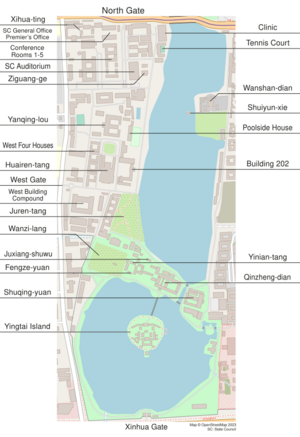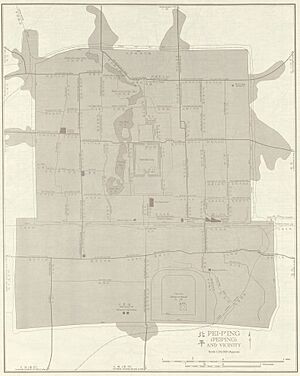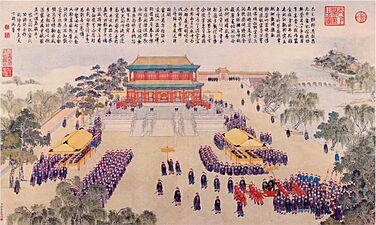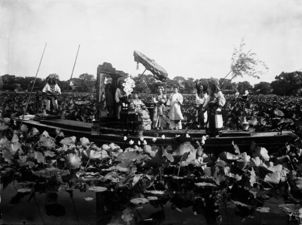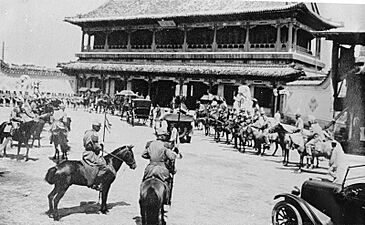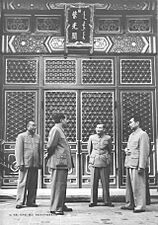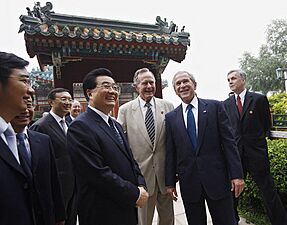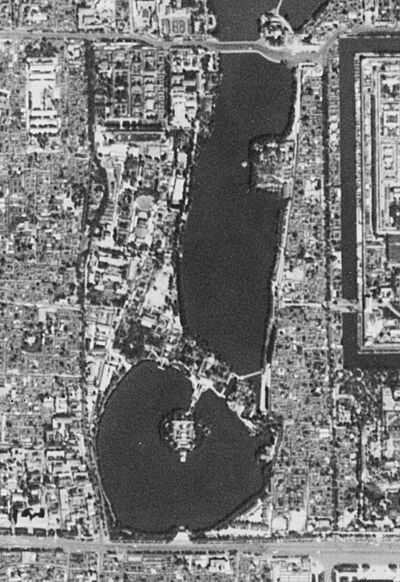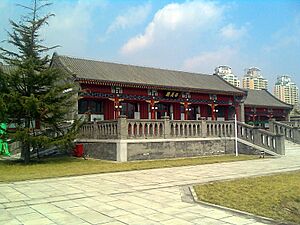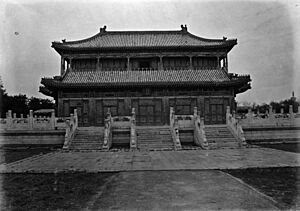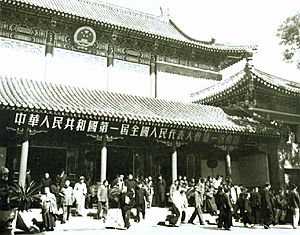Zhongnanhai facts for kids
Quick facts for kids Zhongnanhai中南海 |
|||||||||||
|---|---|---|---|---|---|---|---|---|---|---|---|
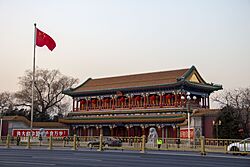
Xinhuamen, the "Gate of New China", built by Yuan Shikai, today the formal entrance to the Zhongnanhai compound
|
|||||||||||
| General information | |||||||||||
| Architectural style | Traditional Chinese architecture | ||||||||||
| Address | 174 Chang'an Avenue, Xicheng District, Beijing | ||||||||||
| Coordinates | 39°54′41″N 116°22′50″E / 39.9113°N 116.3805°E | ||||||||||
| Current tenants |
|
||||||||||
| Chinese name | |||||||||||
| Chinese | 中南海 | ||||||||||
| Literal meaning | "Central and Southern Lakes" | ||||||||||
|
|||||||||||
Zhongnanhai (Chinese: 中南海) is a special place in Beijing, China. It's like the main office and home for China's top leaders. This includes the leaders of the Chinese Communist Party (CCP) and the State Council, which is China's main government body.
Zhongnanhai used to be an imperial garden, right next to the famous Forbidden City. When people say "Zhongnanhai," they often mean the central government and its leaders. Top leaders, like the General Secretary and the paramount leader, work here every day. They meet with important people from other countries.
Even though many maps of the area exist from before 1949, the inside of Zhongnanhai has changed a lot. Many buildings now have the same names as older ones, but their layout and use are different. The complex is split into two main parts. The northern part is for the State Council, where top government officials have their offices and meeting rooms. The southern part is for the CCP Central Committee, where the party's main leaders and staff work. This includes important groups like the Standing Committee and the Politburo.
The basic design of Zhongnanhai started during the Ming dynasty. The Yongle Emperor created a garden retreat around Taiye Lake. Later, in the Qing dynasty, Zhongnanhai became the main government center. Leaders like Empress Dowager Cixi lived and worked there instead of the Forbidden City.
When the Republic of China began, the new president, Yuan Shikai, made Zhongnanhai the official center of government. In 1949, CCP Chairman Mao Zedong moved into the complex. He met many world leaders there, including Nikita Khrushchev and Richard Nixon. Mao loved the Library of Chrysanthemum Fragrance and the Poolside House by the indoor swimming pool. After Mao's death, his library became a museum, but it's not open to the public.
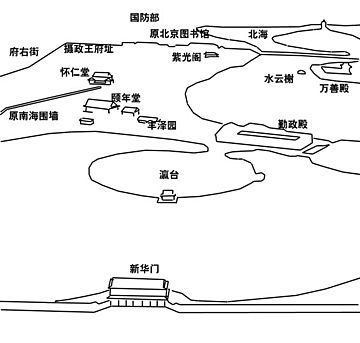
Contents
Location and Lakes

The name Zhongnanhai means "Central and Southern Seas." It refers to two lakes inside the compound: the Central Sea (中海) and Southern Sea (南海). These lakes were part of a bigger project to build the Imperial City. The "Northern Sea" (Beihai) is now a public park nearby.
The three interconnected lakes (Northern, Central, and Southern Seas) are together called Taiye Lake. They were once the heart of an imperial garden known as Western Park (Xiyuan). This park had beautiful lands along the shores and was surrounded by a red wall. Many old buildings and temples from that time are still there.
History of the Compound
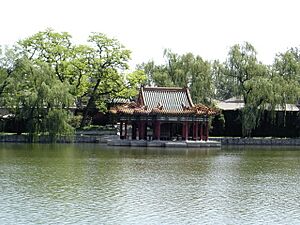
During the Jin dynasty (1115–1235), a northern lake was built in 1189. In the Yuan dynasty (1271–1368), Taiye Lake was made bigger and became part of the Imperial City. Three new palaces were built around it.
When the Ming dynasty moved its capital to Beijing in 1403, the Imperial Palace was built. A new Southern Sea was dug, and the dirt from digging helped form Jingshan Park, a hill north of the Forbidden City. The three lakes were connected and called Taiye Lake, part of the large royal park Xiyuan. Later Ming emperors built more palaces and temples around the lakes and spent a lot of time there.
After the Qing dynasty took over Beijing, they made Xiyuan smaller, focusing on the three lakes. Emperors built pavilions and houses along the lakeshores for government work in the summer. Empress Dowager Cixi and the Emperor often lived in Zhongnanhai, only going to the Forbidden City for special events.
During the Boxer Rebellion (1899–1901), foreign troops took over Zhongnanhai. Many valuable items were stolen. Later, the commander of the Eight-Nation Alliance lived there.
Zhongnanhai remained important when the Republic of China began in 1912. President Yuan Shikai made it the center of his government. He created the main gate we see today, Xinhuamen (the "Gate of New China"). Yuan wanted a new entrance from Chang'an Avenue, separate from the Forbidden City. He even renamed Zhongnanhai the Palace of the New China during his short time as Emperor. When the Republic of China government moved its capital, Zhongnanhai became a public park.
In 1949, after the CCP took Beijing, their leaders decided to move their headquarters to Zhongnanhai. Premier Zhou Enlai thought it would be a good place. Even though Mao Zedong initially didn't want to move there because of its royal past, the leaders agreed. Since then, Zhongnanhai has been the main government center of the People's Republic of China.
When the CCP leaders first moved in, many buildings were old and the gardens were overgrown. Zhongnanhai also needed modern offices and meeting halls. So, new buildings were constructed, and old ones like Huairen Hall were updated by 1954.
Zhongnanhai Today
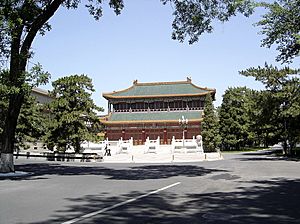
Today, Zhongnanhai is mostly closed to the public. After some political turmoil in 1989, security was greatly increased. You can't just walk in, and there are many security guards. Maps of Beijing show Zhongnanhai as a green area, while the city government is marked with a red star.
The most important entrance is the southern one, Xinhuamen (Xinhua Gate). It has two slogans: "Long live the great Chinese Communist Party" and "long live the invincible Mao Zedong Thought." Behind the gate, a screen wall has Mao Zedong's famous words: "Serve the People."
Zhongnanhai is officially where top leaders like the Politburo Standing Committee members live. However, many senior leaders choose to live in other homes in Beijing. For example, former leader Hu Jintao and current leader Xi Jinping have homes in Jade Spring Hill. There isn't a strict system for who gets which house in Zhongnanhai. If a leader passes away, their family can often stay in the house for a long time.
-
The Empress Dowager Cixi and servants on a boat in Zhonghai in the early 1900s.
-
Leaders of the People's Republic, from left, Zhu De, Mao Zedong, Chen Yun and Zhou Enlai outside the Hall of Purple Light (Ziguangge) in 1954.
-
Chinese leader Hu Jintao with U.S. President George W. Bush and former U.S. President George H. W. Bush at Yingtai in Zhongnanhai in 2008.
Inside Zhongnanhai: Key Buildings
| An annotated map of Zhongnanhai. Click on the links for more information about each building. |
Central Sea Area: Government Headquarters
The buildings around the Central Sea (Chinese: 中海) are where the State Council works. This includes the offices of the Premier and Vice Premiers. Important visitors are usually welcomed here. This area is also called the North District.
Regent Palace
The original Regent Palace (攝政王府; 摄政王府) was a large mansion in the northwest of Zhongnanhai. Today, it's where the State Council holds its main meetings and has offices. The State Council has six meeting rooms for conferences and making policies. The most important meetings, including weekly gatherings of the State Council Standing Committee, happen in conference room number one.
This area was once home to the Jiajing Emperor's palace. Later, it became the palace of Prince Chun, who was a regent for Emperor Puyi. After 1949, it became the headquarters for the Premier and the State Council. The building was rebuilt in the late 1970s because it was very old and weak.
West Flower Hall
West Flower Hall (西花厅; 西花廳) is in the northwest corner of Zhongnanhai. It was the personal home of Premier Zhou Enlai. He met foreign guests in the front courtyard. His office and bedroom were in the back. After Zhou's death, his wife, Deng Yingchao, lived there until 1990.
Next to it is East Flower Hall, where Vice Premier Li Xiannian lived. Later, a large house was built nearby for leader Hua Guofeng. After Hua Guofeng left power, Li Xiannian moved into that house.
Premier's Office
The Premier's Office (总理办公室) is where the Premier and Vice Premiers of the State Council work today. Unlike some other offices, these are for the current leaders in those positions. When their term ends, they move out. South of this office is the headquarters for the State Council General Office.
Fourth Conference Room
The State Council's Fourth Conference Room (第四会议室) is in its own building. It's used for meetings between State Council officials and special guests who are not part of the government. There's a traditional Chinese gate and courtyard in front for photos. This room was last rebuilt in 2003.
Ziguang Hall
Ziguang Hall (Ziguangge; 紫光阁; 紫光閣), or the Hall of Purple Light, is a two-story building on the western bank of the Central Sea. It was first a platform for military exercises in the Ming dynasty. Later, it was rebuilt by the Kangxi Emperor and used to display battle maps and captured weapons. It was also where foreign visitors met the Emperor.
Today, Ziguang Hall is the main place in Zhongnanhai for meeting foreign diplomats and world leaders. The Auditorium of the State Council is connected to its western side. This auditorium is used for ceremonies and conferences on specific government topics.
Indoor Pool
An indoor swimming pool was built in 1955. Mao Zedong often used this pool and even worked there for long periods. In 1958, Mao met Soviet leader Nikita Khrushchev at this pool. Today, senior party leaders use the pool, and it also has a workout area.
Poolside House
The Zhongnanhai outdoor swimming pool was built in 1933 and was once open to the public. After Zhongnanhai became a government-only area, a Poolside House was built next to it for Mao Zedong. Mao often swam or read by the pool, so the house allowed him to stay close. If staff were told "you are wanted at the swimming pool," it meant Mao wanted to see them.
Mao moved into the Poolside House in 1966. In his later years, foreign leaders like Richard Nixon visited him there. After Mao's death in 1976, Zhou Enlai's wife, Deng Yingchao, lived there briefly.
Wan Shan Temple
Also known as Thousand Benevolence Hall (万善殿; 萬善殿), Wan Shan is a Buddhist Temple on the eastern bank of the Central Sea. It was built by the Qing dynasty's Shunzhi Emperor. Inside, there are statues of the Buddha. Behind it is Thousand Sage Hall, which has a dome and a seven-story pagoda.
Water Clouds Pavilion
The Water Clouds Pavilion is on an island in the Central Sea. It has a stone tablet with words written by the Qianlong Emperor, describing "Autumn Wind on the Taiye Lake."
Southern Sea Area: Party Headquarters
The Southern Sea (Nanhai, 南海) area is the headquarters of the CCP. This includes the office of the General Secretary and the staff of the Central Committee General Office. This area is also called the South District.
Huairen Hall
Huairen Hall (怀仁堂; 懷仁堂; 'Hall of Cherished Compassion') is a two-story Chinese-style hall. It's the main meeting place for the CCP's Politburo and sometimes for the Politburo Standing Committee. It also hosts meetings for important party groups.
This building was the daily workplace of Dowager Empress Cixi. After the Boxer Rebellion, it was damaged by fire but rebuilt. After the Republic of China was founded, President Yuan Shikai used it to meet foreign guests.
In September 1949, the first meeting of the Chinese People's Political Consultative Conference (CPPCC) was held here. In 1954, the first session of the National People's Congress also took place in Huairen Hall. It became a central government auditorium, hosting art shows and political meetings.
Qinzheng Hall
Qinzheng Hall (勤政殿; Qínzhèng Diàn) is the headquarters of the Secretariat of the Chinese Communist Party. It's also where the office of the party's General Secretary is located. The General Secretary is currently the top leader of the country. The building has a meeting room for the Politburo Standing Committee.
The General Secretary's personal office is very complete, with a sleeping area for long work hours. There's even a special hotline from Qinzheng Hall to the White House in Washington, D.C. for high-level talks with American leaders.
The original Qinzheng Hall was built by the Kangxi Emperor as his main living and working space in Zhongnanhai. After 1949, it was where the interim government council met. In 1951, the Seventeen Point Agreement about Tibet was signed here. The building was rebuilt in 1980 and became the Secretariat's new headquarters.
Four Blessing Halls
The Four Blessing Halls (四福堂) are old buildings from the time of the Qianlong Emperor. They are named Yongfutang, Laifutang, Zengfutang, and Xifutang. After 1949, important early party officials lived here. For example, China's first Defense Minister, Peng Dehuai, lived in Yongfutang.
West Building Compound
The West Building Compound (西楼大院) is in the southwest of Zhongnanhai. It was built from 1949 to 1951 for the staff of the Central Committee General Office. It's one of the workplaces for the Director of the Central Committee General Office.
This complex became the offices for the State Chairman, Premier, and Vice Chairmen who were Communist Party members. Building A was meant for Mao Zedong, but he preferred his old home. So, it became the home and office of State Vice Chairman Liu Shaoqi in 1950.
Between 2007 and 2008, part of the West Building Compound was rebuilt. The Central Committee General Office now has offices both inside and outside Zhongnanhai. The main gate staff use to go between buildings is called the "Great West Gate."
Garden of Abundant Beneficence

Some buildings in the Garden of Abundant Beneficence (丰泽园; 豐澤園) were built by the Kangxi Emperor. The Qianlong Emperor added more buildings for libraries and a personal retreat.
The largest building here is Dianxu Hall. During the Republic of China, it was the office of the president. After 1949, it became a general meeting area for CCP officials. Politburo meetings were often held here because it was close to Mao Zedong's house.
The Garden of Abundant Beneficence also has Chairman Mao Zedong's first personal home and office, used from 1949 to 1966. This building is called the Library of Chrysanthemum Fragrance (菊香书屋). It's a courtyard-style building with four halls. The north hall was Mao's bedroom and study. The east hall was his office. An air raid shelter was dug in the courtyard, but it wasn't used much. Mao moved to the Poolside House in 1966. After Mao's death, the Chrysanthemum Library became a museum, but it's not open to the public.
Building 202
This building (202别墅) next to Huairen Hall was built in 1974 as a strong earthquake shelter. Mao Zedong moved into Building 202 after an earthquake in July 1976. Mao died in this building on September 9, 1976.
Western Four Houses
The Four Western Houses (西四所) were built as part of the Huairen Hall complex. They were living quarters for servants of Empress Dowager Cixi. After 1949, the Propaganda Department was located here. Later, these buildings became homes for important officials like Li Fuchun, Tan Zhenlin, Deng Xiaoping, and Chen Yi.
Yingtai Island
Yingtai Island (瀛台; 瀛臺) is an artificial island in the Southern Sea. It was finished in 1421 by Ming Emperor Yongle. The island is connected to the shore by a stone bridge. There's a main temple in the north and a two-story pavilion called Penglai Pavilion in the south.
In 1898, Empress Dowager Cixi imprisoned Emperor Guangxu at Hanyuan Temple on Yingtai. Emperor Guangxu later died here in 1908. Since 1949, Yingtai is used for banquets and other events.
Xinhua Gate
<mapframe latitude="39.906211" longitude="116.379736" zoom="17" width="200" height="200">{"type":"Feature","geometry":{"type":"Point","coordinates":[116.379736,39.906211]},"properties":{"title":"Botou Detention Center","marker-color":"#ff0000","marker-size":"medium"}}</mapframe>
The Xinhua Gate is the main entrance to Zhongnanhai, located north of West Chang'an Avenue. It was originally a pavilion built by the Qianlong Emperor in 1758. In 1912, Yuan Shikai turned it into a gate and named it "Xinhua Gate" or "New China Gate."
Today, the walls on both sides of Xinhua Gate have slogans: "Long live the great Chinese Communist Party" and "long live invincible Mao Zedong Thought." On the door, you can see the words "为人民服务" in Mao Zedong's handwriting. In 1959, an underground passage was built between Xinhua Gate and the Great Hall of the People for top leaders to use.
In March 2024, a man tried to drive a car through the Xinhua Gate. Security quickly stopped him. This kind of public protest near the government's main center is very rare.
Images for kids
-
Office buildings in the State Council area of Zhongnanhai
See also
 In Spanish: Zhongnanhai para niños
In Spanish: Zhongnanhai para niños
- Beidaihe District
- Diaoyutai State Guesthouse
- History of Beijing
- Imperial City, Beijing
- Beihai Park
- Summer Palace
- Old Summer Palace
- Jade Spring Hill
- Presidential Palace, Nanjing


